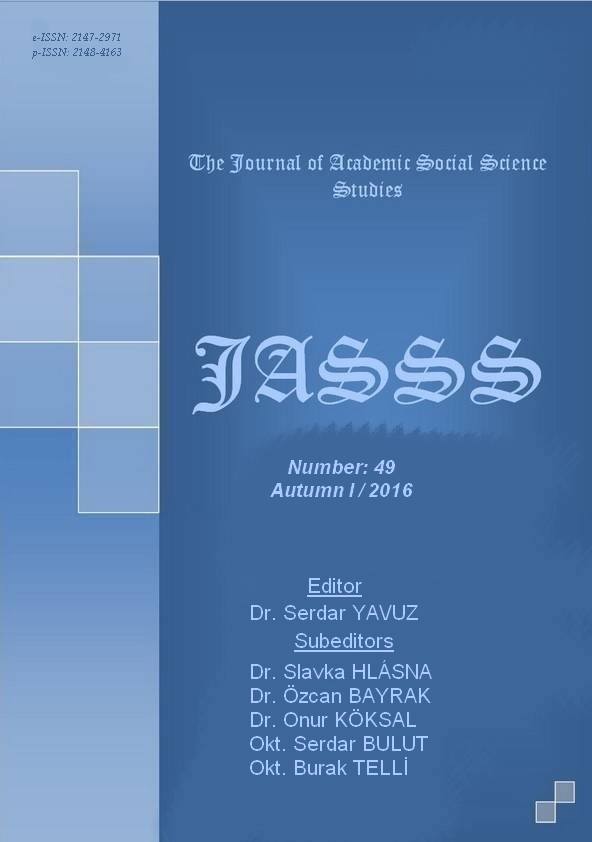İKİ DÜNYA SAVAŞI ARASI DÖNEMDE SİLAHSIZLANMA YOLUNDA ÖNEMLİ BİR ADIM: WASHİNGTON DENİZ KONFERANSI 1921-1922
Author :
Abstract
Washington Deniz Konferansı, I. Dünya Savaşı devam ederken ve savaş sona erdikten sonra Uzak Doğu ve Pasifik’te ortaya çıkan birtakım gelişmelerin sonucudur. Japonya, I. Dünya Savaşı devam ederken büyük devletlerin savaşla meşgul olmasından yararlanarak Uzak Doğu’daki bir kısım toprakları ele geçirmiş, özellikle Çin üzerinde siyasi ve ekonomik nüfuz elde etmişti. Bunu yaparken İngiltere ile 1902 yılında imzaladığı bir ittifak anlaşmasından güç almaktaydı. Japonya’nın bu yayılmacı siyaseti, ABD’nin 1917’de savaşa dâhil olmasıyla birlikte Pasifik’te ABD ile Japonya arasında hızla büyüyen silahlanma yarışına neden olmuş ve bu da iki ülkenin ekonomisine önemli bir külfet getirmiştir. ABD’nin önerisi ile Washington’da büyük devletlerin katılacağı bir konferans düzenlenerek hem silahlanma yarışına bir son vermek, hem de Uzak Doğu’daki problemlere çözüm bulmak amaçlanmıştır. 12 Kasım 1921-6 Şubat 1922 tarihleri arasında toplan Washington Konferansı’nda “Deniz Silahlarının Sınırlanması” ve “Çin’le ilgili Uzak Doğu meselesi” olmak üzere iki ayrı konu müzakere edilmiştir. Bu konular farklı oturumlarda iç içe olmak üzere gündeme gelmiştir. Deniz silahlarının tespiti görüşmelerine ABD, İngiltere, Fransa, İtalya ve Japonya; Uzak Doğu sorununu ele alacak olan görüşmelere ise ABD, İngiltere, Çin, Fransa, Belçika, İtalya, Japonya, Portekiz ve Hollanda katılmıştır. Böylelikle 1902’den itibaren süregelen İngiliz- Japon İttifakı, “Dört Devlet Anlaşmasıyla” sonuca bağlanmış, tarihe “9 Devlet Antlaşması” olarak geçen pakt ile de Çin’in toprak ve idari bütünlüğü diğer devletlerce tanınarak Asya’da çıkarı bulunan her yabancı devlete de eşit ekonomik ve ticari hak ve hukuka sahip olacağı taahhüdü verilmiştir. 6 Şubat 1922’de “Washington Deniz Antlaşması”nın imzalanmasıyla da harp gemileri ile uçak gemilerinin sayı ve oranları tespit edilmiştir.
Keywords
Abstract
The Washington Naval Conference was the result of various developments emerged in Far East and Pacific while the First World War was going on and after the end of it. While the First World War was continuing, by benefiting from the fact that great powers engaged with the war, Japan captured the certain parts of the Far East and it attained political and economic influence particularly on China. On exerting this influence, Japan was taking heart from a treaty of alliance signed with England in 1902. Japan’s this expansionist policy led to the fast growing armament rivalry between USA and Japan in Pacific after USA involved into the war in 1917 and this brought considerable burden to the economies of the both parties. Through the suggestion of USA, by holding a conference in Washington that major countries would attend, it was aimed at both putting an end to armament rivalry and clearing up the problems in Far East. At the Washington Naval Conference held between 12 November 1921 and 6 February 1922, two distinct issues; namely “the Restriction of Naval Weapons” and “the Matter of Far East Concerning China” were debated. These issues brought up in different sessions in the manner of one inside the other. While USA, England, France, Italy and Japan participated to the negotiations of the naval weapon detections; USA, England, China, France, Belgium, Italy, Japan, Portuguese and the Netherland attended to the negotiations dealing with the matter of Far East. Thus, Anglo-Japanese Alliance lasting for four years since 1902 was concluded by “Four- Power Treaty” and by the treaty gone down in history as “Nine-Power Treaty” territorial and administrative integrity of China were recognized by other countries and it was given as a commitment that every foreign country which had interest in Asia would have equal economic and commercial right. By the signing of “the Washington Naval Conference” on 6 February 1922, the number and the ratio of the navy vessels and aircraft carriers were determined.





